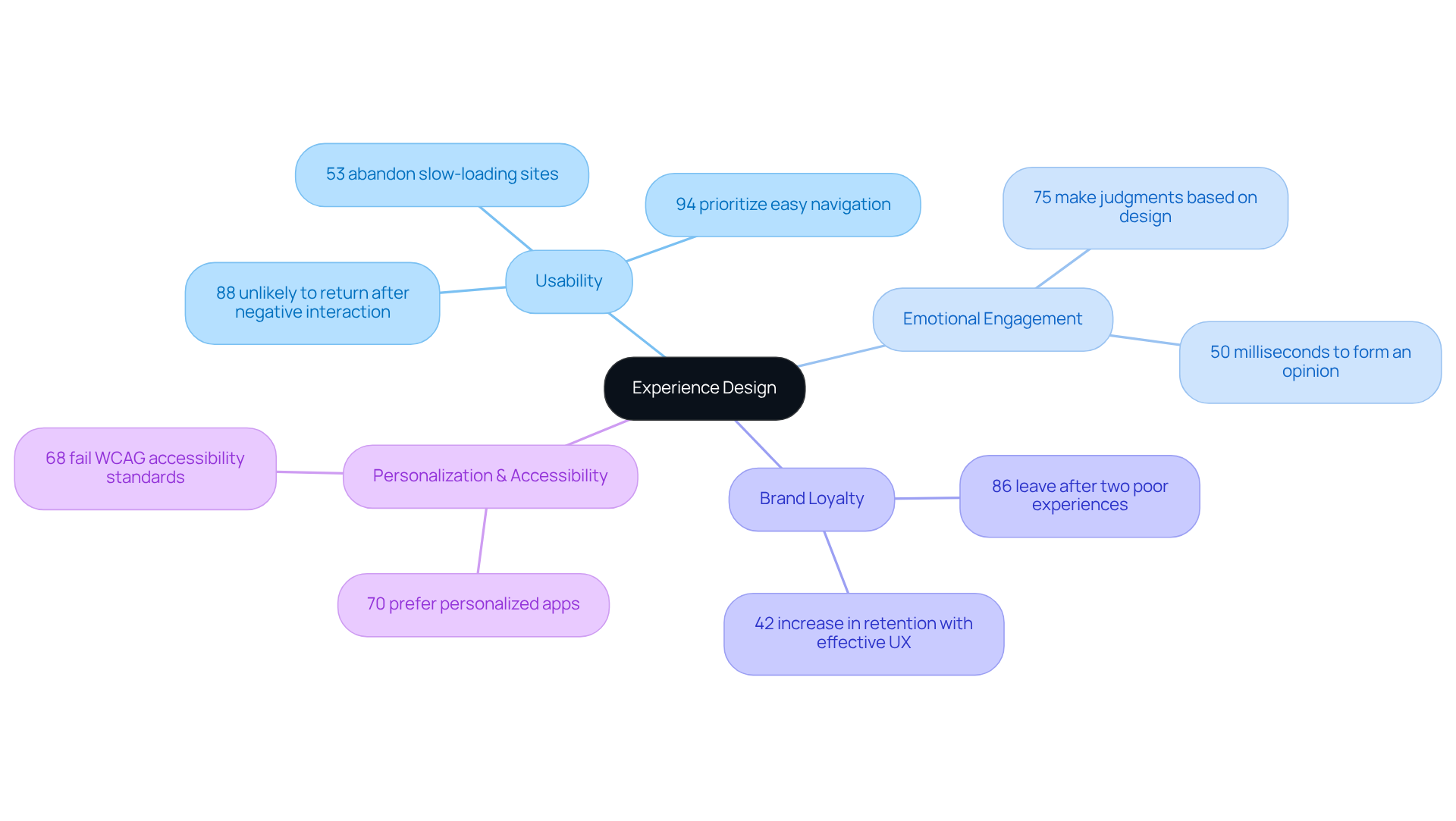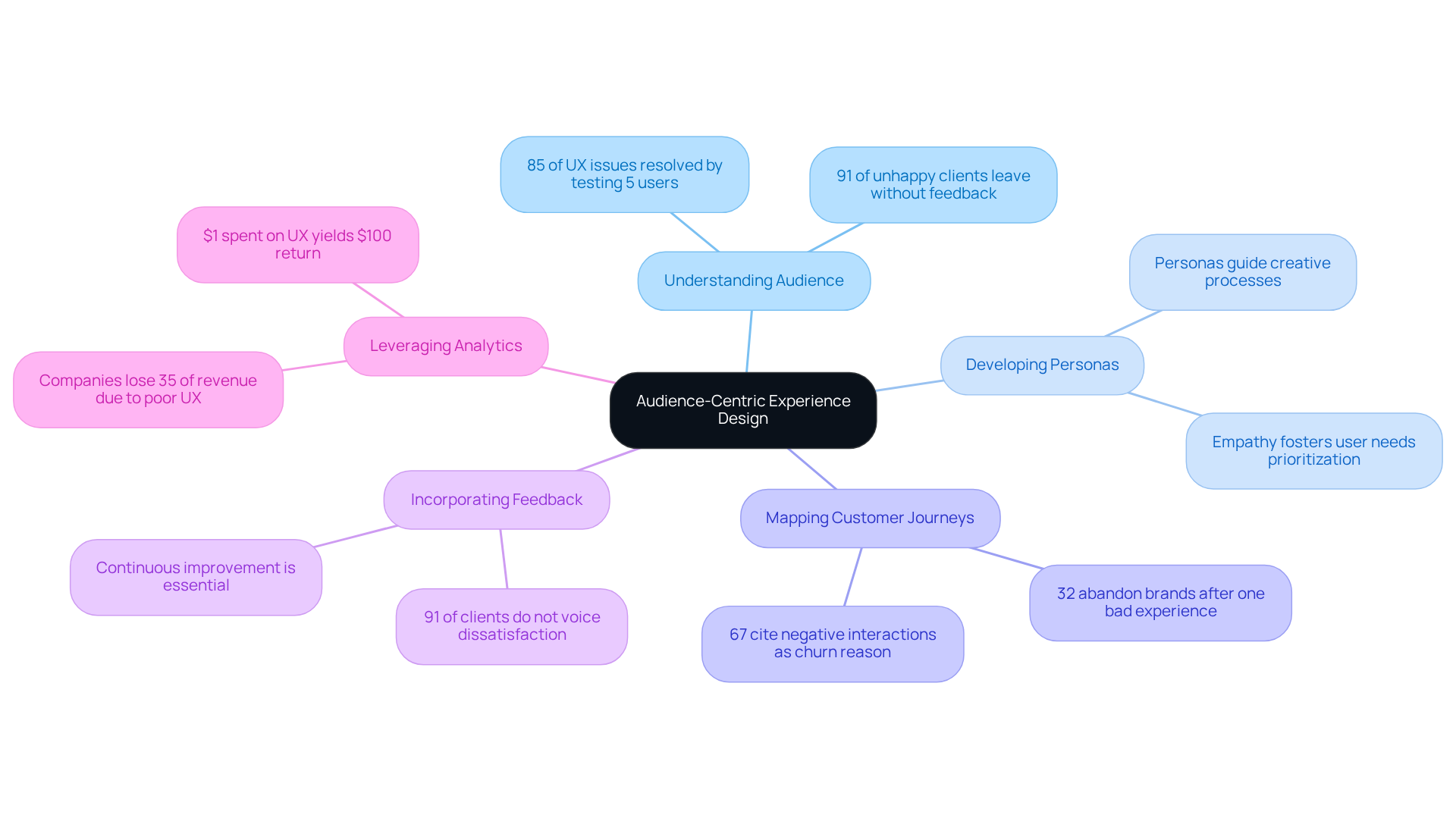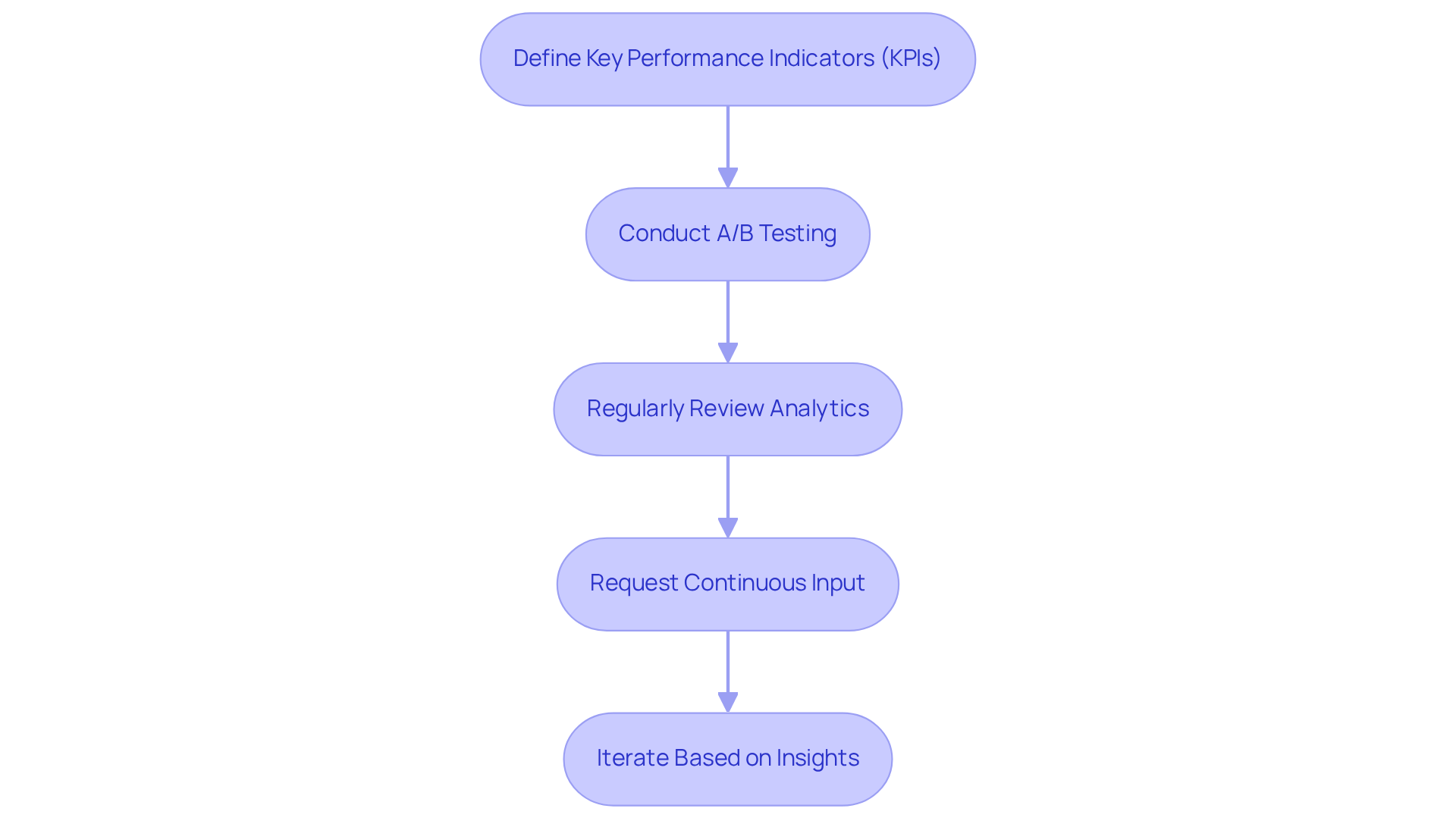Overview
In today's fast-paced digital world, many tech startup founders grapple with the challenge of designing experiences that truly engage their audiences. This struggle can lead to feelings of frustration, as they recognize that without meaningful interactions, user satisfaction dwindles, and business success becomes elusive. It’s a common pain point that can leave founders feeling overwhelmed.
However, there is hope. The article outlines four key practices that can transform this challenge into an opportunity for growth. By emphasizing:
- Client-centricity
- Consistency
- Hierarchy
- Accessibility
These practices not only foster meaningful interactions but also enhance user satisfaction. Supported by insightful statistics, they highlight the importance of creating experiences that resonate deeply with audiences.
Imagine the relief of knowing that by implementing these practices, you can cultivate a more engaged user base and drive business success in a competitive landscape. These insights serve as a guiding light, offering a supportive pathway for founders to connect with their audiences on a deeper level.
As you embark on this journey, remember that you are not alone. Many have faced similar hurdles, and by sharing experiences and insights, we can foster a community of support and understanding. Embracing these practices can lead to a more fulfilling and successful venture, ultimately bringing your vision to life.
Introduction
In today's fast-paced world, designing an engaging experience is not just a luxury; it’s a necessity. User expectations are soaring, and as brands, we find ourselves striving to create meaningful interactions that truly resonate with our audiences. This can feel overwhelming, can't it? Understanding the core principles of experience design is not merely beneficial; it’s essential for fostering connections that matter.
As we navigate this landscape, we must acknowledge the challenges we face. The pressure to meet these high expectations can lead to frustration and uncertainty. How do we ensure that our designs not only satisfy users but also contribute to our business success? This article explores four key practices that can enhance user satisfaction while driving our goals forward. Together, we’ll raise an important question: How can we effectively bridge the gap between user needs and innovative design? By doing so, we can foster lasting connections that truly make a difference.
Define Experience Design and Its Importance
Designing an experience is about fostering meaningful interactions between users and products or services. It addresses critical aspects like usability, accessibility, and emotional engagement. In our fast-paced digital world, brands face the challenge of standing out, and effective design of interactions is essential for achieving this. RNO1 embodies this commitment with a design-focused approach, ensuring that every interaction is crafted with intention and creativity.
Imagine the frustration of visiting a site that doesn't meet your needs; studies reveal that 88% of individuals are unlikely to return after a negative interaction. This statistic underscores the importance of usability in nurturing brand loyalty. When businesses prioritize customer satisfaction through , they can experience a remarkable 42% increase in retention, illustrating the direct connection between creating satisfaction and achieving business success.
Recent trends emphasize the significance of personalization and accessibility, with 70% of mobile users preferring apps that intuitively cater to their preferences. RNO1's innovative collaborations with creative startups showcase how thoughtful planning can transform interactions and enhance brand visibility.
As brands navigate the evolving digital landscape, designing an experience that prioritizes interaction creation not only deepens engagement but also fosters sustainable growth and a competitive advantage. Together, we can embrace these challenges and work on designing an experience that resonates deeply with users.

Explore Core Principles of Effective Experience Design
Effective experience design is rooted in fundamental principles that nurture user engagement and satisfaction:
- Client-Centricity: We understand that prioritizing client needs is essential. By conducting thorough research, we can truly grasp individual goals, pain points, and behaviors, which is essential for designing an experience. Imagine discovering that 85% of UX issues can be resolved by simply testing five individuals. This statistic underscores the value of direct feedback from participants during the development process. At RNO1, we are committed to designing an experience by actively engaging with individuals and enhancing our creations to ensure they meet practical requirements and resonate with users.
- Consistency: Picture a digital landscape where a cohesive visual language guides you effortlessly. Consistency across all platforms fosters smooth interactions, encompassing visual elements, tone of voice, and interaction patterns. Companies that maintain a unified design approach can significantly boost trust and engagement; after all, 94% of initial impressions are design-related. At RNO1, we exemplify this by designing an experience that ensures our branding and digital growth strategies are consistently applied across all touchpoints, creating a recognizable and trustworthy presence for all.
- Hierarchy: Navigating information should feel intuitive and seamless. By organizing content effectively and utilizing visual indicators, we can guide individuals through their journey. Studies show that familiar navigation schemes can reduce cognitive load, leading to a more enjoyable experience. At RNO1, we are dedicated to designing an experience that harnesses design to create intuitive hierarchies, making it easy for individuals to find what they need without frustration.
- Accessibility: We believe that designs must be inclusive, catering to individuals of all abilities. This means considering critical aspects like color contrast, font sizes, and navigational aids. With 32% of individuals likely to abandon a brand after a single negative interaction, ensuring accessibility profoundly impacts retention rates. At RNO1, we are committed to designing an experience that is innovative and accessible to everyone, fostering engagement and loyalty through thoughtful design decisions.
- Feedback: Clear feedback on participant actions is vital. Whether through visual changes, sounds, or notifications, confirming interactions helps individuals feel confident and satisfied. Prompt feedback not only boosts confidence but also increases the likelihood of further engagement with the product. At RNO1, we recognize that designing an experience with efficient feedback systems is crucial for developing , and we implement methods that keep individuals informed and involved.
By embracing these principles, brands can excel in designing an experience that cultivates engaging digital interactions resonating with individuals, fostering meaningful connections. This philosophy is at the heart of RNO1's mission to revolutionize digital branding, and we are here to support you on this journey.
Implement Strategies for Audience-Centric Experience Design
Designing an experience that is centered around the audience is essential, yet many face challenges in doing so. Without a deep , you risk missing out on meaningful interactions and potential growth. Consider this: studies show that 85% of UX issues can be resolved by evaluating just five participants. However, only 55% of firms currently engage in experience testing. This gap highlights a significant opportunity for improvement. At RNO1, we understand the importance of direct input in guiding design choices, and we leverage our insights into client motivations to develop powerful strategies that yield rapid ROI, including our Digital Strategy and UX & UI Design services.
To foster empathy and prioritize user needs, developing detailed audience personas is crucial. These personas guide your creative process, ensuring that the voices of your target market segments are heard and valued. At RNO1, this user-centric approach is foundational to our digital platform, which emphasizes designing an experience that empowers brands to connect meaningfully with their audiences.
Mapping customer journeys is another vital step. By outlining the steps individuals take when interacting with your product or service, you can identify pain points and opportunities for enhancement. It's alarming to note that 32% of users will abandon a beloved brand after just one negative experience, and 67% cite negative interactions as a reason for churn. RNO1's innovative digital product design approaches focus on improving these experiences, promoting user-focused development that nurtures customer loyalty.
Incorporating feedback loops is essential for ongoing improvement. Many clients, about 91%, do not voice their dissatisfaction but simply leave, which underscores the need for proactive engagement. At RNO1, we emphasize the importance of continuous enhancement in our digital activation processes to ensure participant satisfaction.
Leveraging analytics tools allows you to monitor participant behavior and engagement metrics. Analyzing this data can reveal trends and opportunities for improvement, ensuring your strategy aligns with audience expectations and preferences. Companies reportedly lose 35% of revenue due to insufficient client interaction, highlighting the financial impact of neglecting analytics in UX planning. At RNO1, we believe that every $1 spent on UX can yield $100 in return, reinforcing the value of prioritizing client satisfaction in your creative process.
By integrating these strategies, you not only enhance user satisfaction but also recognize that investing in UX brings substantial benefits. It's vital to prioritize user usability in your creative endeavors, fostering a supportive environment where both your audience and your business can thrive.

Measure and Iterate for Continuous Improvement
To foster continuous improvement in experience design, it’s essential to embrace practices that truly resonate with your audience's needs:
- Define Key Performance Indicators (KPIs): Establishing clear metrics is crucial for evaluating the success of your designs. Think about common KPIs such as customer satisfaction scores, conversion rates, and task completion times. Aiming for a task success rate of 78% can indicate effective usability, while the average Customer Satisfaction Score (CSAT) for e-commerce products, sitting at 77, serves as a valuable benchmark for user satisfaction.
- Conduct A/B Testing: Experimenting with different layout variations can reveal what resonates best with your users. A/B testing has proven effective in enhancing outcomes, and studies show companies often see a significant rise in conversion rates through this method. For instance, a case study on conversion rate analysis highlighted that improved rates reflect effective design strategies and user-focused interactions. Shivani Dubey emphasizes the importance of understanding UX metrics to enhance experiences for individuals, reminding us that insight can lead to profound improvements.
- Regularly Review Analytics: It’s vital to continuously monitor individual behavior through analytics tools. Look for patterns and insights that can guide your future development iterations. Monitoring metrics like time-on-task and mistake rates—where a mistake rate of 10% indicates usability issues—can illuminate areas needing enhancement, ensuring your designs remain intuitive and user-centered.
- Request Continuous Input: Creating avenues for individuals to provide feedback, even after the initial launch, is essential. This might include surveys, feedback forms, or community forums. Regular CSAT surveys can help monitor customer satisfaction and pinpoint areas for enhancement, with the average CSAT score for e-commerce products being 77.
- Iterate Based on Insights: Leverage the data and feedback you collect to make thoughtful, iterative improvements to your designs. This agile approach is essential for designing an experience that remains relevant and engaging for individuals. By focusing on user needs and making careful adjustments based on metrics, companies can enhance user interactions and achieve their business goals.
Remember, each step taken towards understanding and improving user experience not only benefits your designs but also nurtures a deeper connection with your audience.

Conclusion
Designing an engaging experience presents a challenge for many brands striving to connect meaningfully with their audiences. This struggle can lead to frustration, as businesses may find that without prioritizing user interactions, they risk losing customer satisfaction and loyalty, ultimately hindering sustainable growth. The principles of effective experience design—client-centricity, consistency, hierarchy, accessibility, and feedback—serve as a nurturing foundation for creating interactions that resonate deeply with users.
It’s essential to understand the needs of your audience through thorough research and testing. Maintaining a cohesive design across platforms is not just a technical requirement; it’s a way to show your audience that you care about their experience. Incorporating user feedback is vital for continuous improvement, allowing brands to adapt and grow alongside their customers. By embracing audience-centric strategies and measuring success through relevant KPIs, you can refine your approach, ensuring that your designs remain impactful and relevant.
Ultimately, the journey of experience design is an ongoing process. Embracing an iterative approach that values user feedback and analytics can lead to profound improvements in engagement and satisfaction. As you navigate the complexities of the digital landscape, remember that prioritizing effective experience design is not just about enhancing user interactions; it’s about fostering a community that supports long-term success in an ever-evolving market. Share your experiences, and let’s grow together in this journey.
Frequently Asked Questions
What is experience design?
Experience design is the process of creating meaningful interactions between users and products or services, focusing on usability, accessibility, and emotional engagement.
Why is experience design important for brands?
Experience design is crucial for brands because it helps them stand out in a competitive digital landscape, fosters customer satisfaction, and enhances brand loyalty.
What impact does poor user experience have on customer retention?
Studies show that 88% of individuals are unlikely to return to a site after a negative interaction, highlighting the importance of usability in retaining customers.
How can effective UX strategies influence business success?
Prioritizing customer satisfaction through effective UX strategies can lead to a remarkable 42% increase in customer retention, demonstrating the connection between satisfaction and business success.
What recent trends are shaping experience design?
Recent trends emphasize personalization and accessibility, with 70% of mobile users preferring apps that cater intuitively to their preferences.
How does RNO1 approach experience design?
RNO1 adopts a design-focused approach, ensuring that every interaction is crafted with intention and creativity, and collaborates with creative startups to enhance brand visibility.
What are the benefits of designing an experience that prioritizes interaction?
Designing an experience that prioritizes interaction deepens user engagement, fosters sustainable growth, and provides a competitive advantage for brands.




